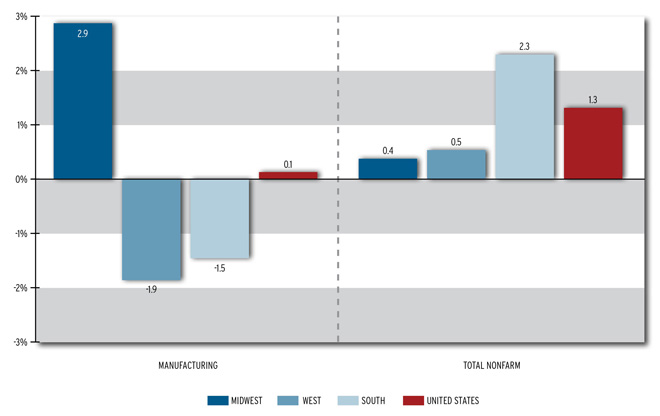In the Super Bowl halftime ad that ran on February 5, Clint Eastwood compares the current state of the U.S. economy to halftime in a football game. It’s a comparison the ad uses to describe Detroit’s economic comeback: “Motor City,” Eastwood said, “is fighting again.” While it is early in the second half, it might be worth seeing if Detroit and other hard-hit manufacturing centers are making much headway toward the distant goal line.
An examination of job growth in metropolitan areas with large minority and immigrant populations shows that many of these communities suffered from a loss of manufacturing jobs that was not offset by job growth in other sectors between 2000 and 2009. What has happened to the 15 metros that were labeled “high-manufacturing areas”?
Average Job Growth in High Manufacturing Metro Areas, 2009-2011

Source: Urban Institute analysis of BLS Current Employment Statistics (CES) Data
The MetroTrends interactive map on job growth shows that overall job growth in these communities between 2009 and 2011 ranged from -1.5 percent (in Stockton, CA) to 5.3 percent (in Nashville, TN). Job growth in the 15 high-manufacturing areas reflects patterns in other metros, which generally saw private job gains or losses between zero and 4 percent. In the manufacturing sector, some metros did better and some did worse, with job growth ranging from -5.4 percent (in Augusta, GA) to 18.6 percent (in Detroit, MI). Eight of the 15 metros experienced net losses of manufacturing jobs between 2009 and 2011: Augusta, Los Angeles, Indianapolis, Charlotte, Stockton, Chicago, Oxnard, and Minneapolis.
Of the seven metro areas where manufacturing jobs grew, five had gains above the national average of 1.3 percent: San Jose, Houston, Cleveland, Milwaukee, and Detroit. The Midwest region had some of the highest rates of growth in manufacturing jobs between 2009 and 2011, but also some of the lowest rates. In the South and West, manufacturing jobs shrank or grew minimally between 2009 or 2011, with the exception of Houston and San Jose. But win or lose, these 15 metros were all in the top half of the 100 largest metros in terms of manufacturing job growth.
So it looks like the Motor City and some older industrial centers are gaining yardage early in the second half of the recovery, but the goal of robust employment growth is still a long way away for many of them.
Let’s build a future where everyone, everywhere has the opportunity and power to thrive
Urban is more determined than ever to partner with changemakers to unlock opportunities that give people across the country a fair shot at reaching their fullest potential. Invest in Urban to power this type of work.